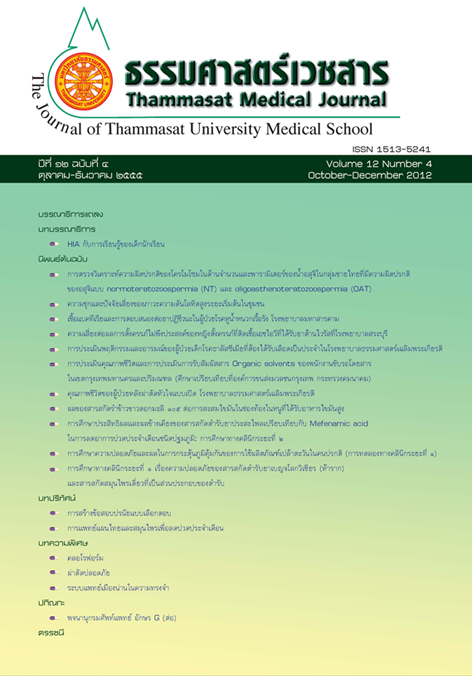Analysis of semen parameters and sperm numerical chromosome abnormalities in normoteratozoospermic and oligoasthenoteratozoospermic men from Thailand
Keywords:
Multi-color-fl uorescence in situ hybridization (FISH) assay, Sperm aneuploidy, Semen parameters, Infertility, Chromosome abnormalityAbstract
Sperm from infertile males who desire children is frequently used for intracytoplasmic sperm injection (ICSI).Concerns about the chromosome quality of these donated sperm and the risk for the transmission of genetic defectsare under-recognized. We conducted a chromosome study using sperm from 15 Thai men (26-40 years of age; mean,32 years of age) who were classifi ed as normoteratozoospermia (NT; 7 cases) and oligoasthenoteratozoospermia (OAT;8 cases). The multi-color FISH (Fluorescence in situ hybridization) assay for the analysis of chromosomes 18, X, and Ywas used on 13,428 sperm from these donors, and we observed statistically signifi cant differences in numerical chromosomeabnormalities between these two groups (p = 0.011). The median (range) for numerical chromosome abnormalitieswere 1.07% (0.18-2.35%) and 9.21% (0.48-29.84%) for sperm from the NT and OAT donors respectively. XY disomywas the most frequent abnormality observed. Correlation with semen parameters indicated that there were signifi cantinverse correlations between sperm chromosomal abnormalities and both normal motile sperm (r = -0.554; p = 0.032),and normal head sperm (r = -0.686; p = 0.005). From our data, statistical analyses indicated that semen samples withnormal motility of ≤60% or normal head morphology of ≤85% had an increased risk of sperm chromosomal abnormalities.The results of this study indicated that OAT men were at increased risk for paternal transmission of genetic defectsto their offspring. Therefore, sperm chromosome analyses and semen analyses are needed to be carefully evaluated onOAT men before performing the ICSI procedure.
Key words: Multi-color-fl uorescence in situ hybridization (FISH) assay; Sperm aneuploidy, Semen parameters, Infertility,Chromosome abnormality


